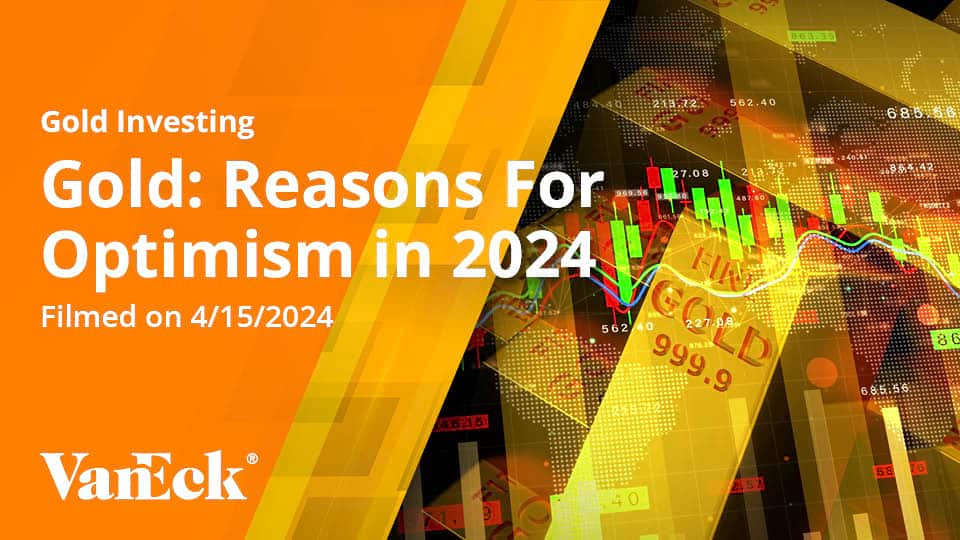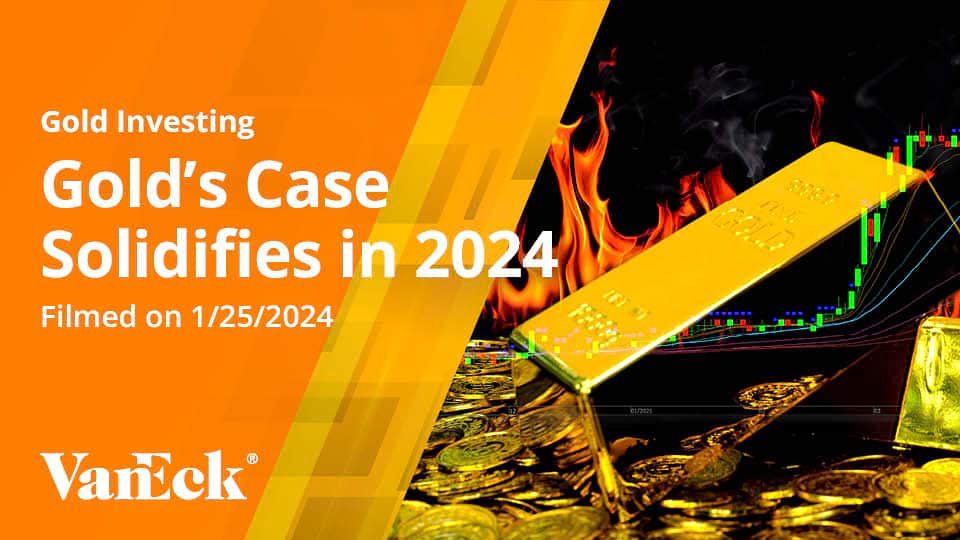With Gold at New Highs, Miners Consider More than Price
10 April 2024
Read Time 5 MIN
Monthly gold market and economic insights from Imaru Casanova, Portfolio Manager, featuring her unique views on mining and gold’s portfolio benefits.
Gold Reaches New All-Time Highs
After several failed attempts over the last three years, gold finally managed to break through its August 2020 high of $2,075 per ounce. This time, the breakout was decisive, with gold closing new all-times high every week in March. The strong rally took gold to a close of $2,229.87 per ounce on March 28, a whopping 9.08% ($185.56 per ounce) monthly gain. Gold continued to set fresh highs in the first few days of April. While COMEX gold open interest and net long positioning did increase in March, gold bullion exchange traded fund holdings continued to decline, after a few days of net inflows.
We have been highlighting the widening valuation gap between gold and gold equities. In March, gold equities finally displayed their leverage to the gold price. This may mark the beginning of a long-anticipated trend reversal for gold mining equities. After years of underperformance against the metal, the NYSE Arca Gold Miners Index (GDMNTR)1 and the MVIS Global Juniors Gold Miners Index (MVGDXJTR)2 significantly outperformed gold in the month of March, up 19.61% and 21.50%, respectively. Year to date, as of the end of March, gold is up 8.09%, and gold equities are finally posting a gain, with GDMNTR up 1.27% and MVGDXJTR up 1.14%.
Where from Here?
We believe gold has the potential to trade in a higher range – above the $2,000 per ounce level – in 2024. In recent years, strong rallies, such as the one gold has been enjoying this past month, have often been followed by periods of consolidation around an established, higher level with the metal trading in a sideways pattern until a new catalyst emerges driving prices even higher. The return of investment demand, as evidenced by inflows into global gold bullion ETFs, could be that catalyst, with a potential to drive gold above $2,500 per ounce, in our view.
For Miners, It’s About More Than Just the Gold Price…
A rising gold price environment has historically been accompanied by strong performance by gold equities. The sector outperformers must also demonstrate that they are fundamentally positioned and have a sound strategy that will translate higher gold prices into improved cash flow and higher returns, which will deliver growth. Organic growth does not come easy in the gold sector. Finding new gold deposits, or defining/expanding existing ones, is a difficult, lengthy, and capital-intensive process. Most senior and mid-tier companies struggle to simply replace their annual production. To significantly expand their depleting reserve and resource base, companies generally must acquire other companies or assets. All things equal, the more advanced a project is, the higher its valuation and the faster the company can deliver growth.
But acquiring the right projects is not easy either. Companies must achieve an acceptable balance between the price paid and the level of risk associated with the project, and they must demonstrate to markets their ability to deliver attractive returns. There were many terrible acquisitions in the past gold bull market when companies were rushing to increase production…at any cost. Gold stocks were punished for it, companies learned and today the sector leaders are disciplined and cautious acquirers.
Alamos + Argonaut: A Blueprint for Deal Making
Last month, Alamos Gold (5.78% of Strategy net assets), one of the Strategy’s top holdings, announced that it had entered into a definitive agreement to acquire all of the issued and outstanding shares of Argonaut Gold (not held by Strategy). There are several aspects of this transaction worth highlighting:
- Alamos has a good acquisition track record. Today, the consensus net present value of its acquired asset base far exceeds its acquisition costs, demonstrating value creation. The market rewarded that successful execution history with the stock trading up 7% on the day the deal was announced (March 27), despite it being an all-share deal resulting in the issuance of shares representing about 5% of the company’s market cap.
- Alamos expects to realize immediate synergies from the use of shared infrastructure, which combined with operating, procurement and tax savings should lead to more than $515M in synergies.
Alamos: demonstrating sound value creation via thoughtful acquisition
Acquisition Savings & Synergies
1 Synergies pre-tax and undiscounted over life of mine; after-tax discounted value of synergies is $250m
Estimated NPV and FCF by Project
Source: Alamos Gold. Data as of March 2024.
1 Based on consensus analyst net present value (NPV) estimates
2 Cumulative free cash flow (FCF) generated since acquisition as of Q4 2023. Please refer to Cautionary Notes on non-GAAP Measures and Additional GAAP Measures
3 Acquisition cost based on the value of Richmont Mines on closing ($627 million), net of $58 million in cash on its balance sheet. Royalty & NPI repurchases totaled $71 million
- The proposed transaction includes the spin out of Argonaut’s non-core assets to its existing shareholders as a newly created junior gold producer. Alamos existing shareholders don’t have to worry about the integration of these assets into Alamo’s portfolio.
- Under the proposed transaction, Alamos will acquire Argonaut’s Magino mine, which is located adjacent to its Island Gold mine in Ontario, Canada, making this combination very logical. The integration of these two operations is significantly de-risked as a result, and will create one of the largest and lowest cost gold mines in Canada.
- With the addition of Magino, Alamos’ assets in Canada will represent more than 85% of the company’s consensus net asset value, potentially leading to higher valuation multiples for the company to reflect an improved geopolitical risk profile.
- The Magino mine reached commercial production in November 2023, so the acquired asset delivers immediate production (and cash flow) growth to Alamos, with an estimated mine life of 19 years and the potential for mine life extensions from a large mineral resource base.
Disciplined and Consistent Approach
Alamos management carefully executed the process to achieve this growth. It has long been in a position to make acquisitions given its strong balance sheet and cash flow generation. However, it was patient, choosing instead to deploy capital to extend and expand its existing mines, until the right opportunity came about. This acquisition is a slam dunk. Plain and simple. It makes sense, as highlighted by the points above. Alamos needs to demonstrate to the markets once again that it can unlock the promised value from this combination. This disciplined and consistent approach has earned the company a premium valuation relative to its peers and should lead to continued outperformance.
1NYSE Arca Gold Miners Index (GDMNTR) is a modified market capitalization-weighted index comprised of publicly traded companies involved primarily in the mining for gold. 2MVIS Global Junior Gold Miners Index (MVGDXJTR) is a rules-based, modified market capitalization-weighted, float-adjusted index comprised of a global universe of publicly traded small- and medium-capitalization companies that generate at least 50% of their revenues from gold and/or silver mining, hold real property that has the potential to produce at least 50% of the company’s revenue from gold or silver mining when developed, or primarily invest in gold or silver.
Related Insights
IMPORTANT DEFINITIONS & DISCLOSURES
This material may only be used outside of the United States.
This is not an offer to buy or sell, or a recommendation of any offer to buy or sell any of the securities mentioned herein. Fund holdings will vary. For a complete list of holdings in VanEck Mutual Funds and VanEck ETFs, please visit our website at www.vaneck.com.
The information presented does not involve the rendering of personalized investment, financial, legal, or tax advice. Certain statements contained herein may constitute projections, forecasts and other forward looking statements, which do not reflect actual results. Information provided by third-party sources are believed to be reliable and have not been independently verified for accuracy or completeness and cannot be guaranteed. Any opinions, projections, forecasts, and forward-looking statements presented herein are valid as of the date of this communication and are subject to change without notice. The information herein represents the opinion of the author(s), but not necessarily those of VanEck.
The views contained herein are not to be taken as advice or a recommendation to buy or sell any investment in any jurisdiction, nor is it a commitment from Van Eck Associates Corporation or its subsidiaries to participate in any transactions in any companies mentioned herein. This content is published in the United States. Investors are subject to securities and tax regulations within their applicable jurisdictions that are not addressed herein.
All investing is subject to risk, including the possible loss of the money you invest. As with any investment strategy, there is no guarantee that investment objectives will be met and investors may lose money. Diversification does not ensure a profit or protect against a loss in a declining market. Past performance is no guarantee of future results.

